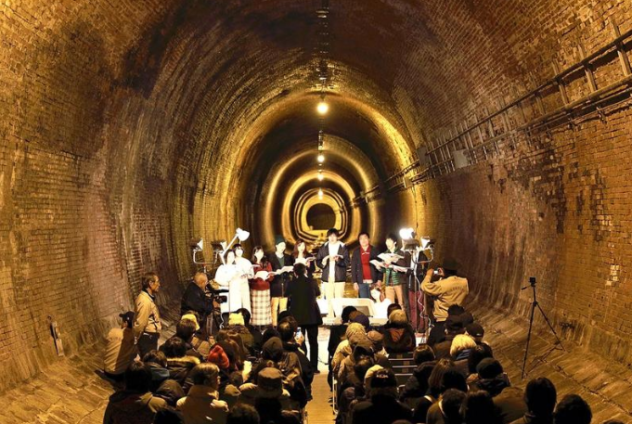Photo by © The Japan News/ANN via
China Daily
Vocabulary:
- reroute /re-ROOT/
[verb] to change the route of someone or something
The police should reroute the parade to avoid any traffic.
- signify /SIG-nuh-fahy/
[verb] to mean something
The smoke signal signifies that the war is over.
- resonate /REZ-uh-neyt/
[verb] to produce or be filled with clear, continuing sound
Her voice resonated within the hallway.
- ambient /AM-bee-uhnt/
[adjective] relating to the immediate surroundings of something
The ambient lighting and good music are the reasons why I want to study in that place.
- relish /REL-ish/
[verb] to like or enjoy something
All of the people relished the sensation of watching the concert last night.
The tunnel is considered as Japan’s oldest water tunnel. It was originally built to reroute the then Minatogawa river streaming through Kobe.
It was built in the wake of a flood in 1896 and was completed in 1901. Also, it was considered as one of the largest river tunnels in the world at that time with a height of 7.6 meters and a width of 7.3 meters. The way the tunnel was built signifies that it had an advanced architecture when it was made.
The tunnel’s unique architectural design makes the sound resonate in an ambient manner within its walls. 180 people relished the concert held by a local chorus of students and others last February 2019. Despite having 10 C temperature that day, the performers’ clear singing voices echoed all over the tunnel in a dim light.
“Their singing voices came down from the ceiling, and I felt like I was being enveloped in them,” said Chiaki Shimizu, 50, who visited for the first time from Nara Prefecture. Even up to this day, there are many inquiries from people asking to perform there. Guests from outside Kobe come to visit the tunnel as well.
Comprehension Questions:
- Where is Minatogawa Zuido located?
- When was Minatogawa Zuido built?
- What kind of live performances are played in the water tunnel?
- What is the height and width of Minatogawa Zuido?
- How many people went to the concert in Minatogawa Zuido last February 2019?
Discussion Questions:
- Do you want to visit Minatogawa Zuido? Why or why not?
- Why do you think many people visit Minatogawa Zuido? Please explain your answer.
- Do you like listening to music? Why or why not?
- Have you been to a music concert? If yes, tell me more. If no, why not?
- Do you think music makes the world a better place to live in? Please explain your answer.
※レッスン教材に関するアンケートのお願い
[verb] to change the route of someone or something
The police should reroute the parade to avoid any traffic.
[verb] to mean something
The smoke signal signifies that the war is over.
[verb] to produce or be filled with clear, continuing sound
Her voice resonated within the hallway.
[adjective] relating to the immediate surroundings of something
The ambient lighting and good music are the reasons why I want to study in that place.
[verb] to like or enjoy something
All of the people relished the sensation of watching the concert last night.
It was built in the wake of a flood in 1896 and was completed in 1901. Also, it was considered as one of the largest river tunnels in the world at that time with a height of 7.6 meters and a width of 7.3 meters. The way the tunnel was built signifies that it had an advanced architecture when it was made.
The tunnel’s unique architectural design makes the sound resonate in an ambient manner within its walls. 180 people relished the concert held by a local chorus of students and others last February 2019. Despite having 10 C temperature that day, the performers’ clear singing voices echoed all over the tunnel in a dim light.
“Their singing voices came down from the ceiling, and I felt like I was being enveloped in them,” said Chiaki Shimizu, 50, who visited for the first time from Nara Prefecture. Even up to this day, there are many inquiries from people asking to perform there. Guests from outside Kobe come to visit the tunnel as well.
